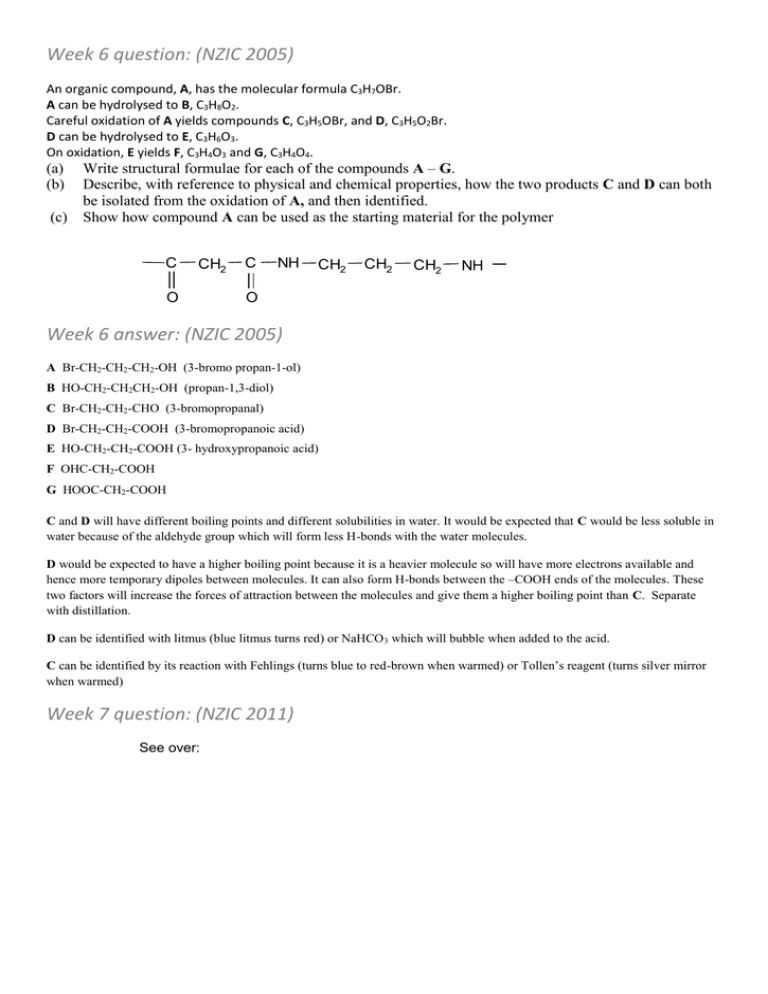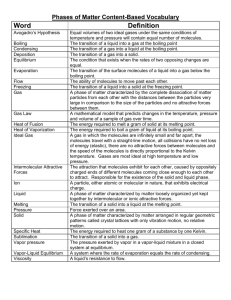Term 1 week 7
advertisement

Week 6 question: (NZIC 2005) An organic compound, A, has the molecular formula C3H7OBr. A can be hydrolysed to B, C3H8O2. Careful oxidation of A yields compounds C, C3H5OBr, and D, C3H5O2Br. D can be hydrolysed to E, C3H6O3. On oxidation, E yields F, C3H4O3 and G, C3H4O4. (a) (b) (c) Write structural formulae for each of the compounds A – G. Describe, with reference to physical and chemical properties, how the two products C and D can both be isolated from the oxidation of A, and then identified. Show how compound A can be used as the starting material for the polymer C CH2 O C NH CH2 CH2 CH2 NH O Week 6 answer: (NZIC 2005) A Br-CH2-CH2-CH2-OH (3-bromo propan-1-ol) B HO-CH2-CH2CH2-OH (propan-1,3-diol) C Br-CH2-CH2-CHO (3-bromopropanal) D Br-CH2-CH2-COOH (3-bromopropanoic acid) E HO-CH2-CH2-COOH (3- hydroxypropanoic acid) F OHC-CH2-COOH G HOOC-CH2-COOH C and D will have different boiling points and different solubilities in water. It would be expected that C would be less soluble in water because of the aldehyde group which will form less H-bonds with the water molecules. D would be expected to have a higher boiling point because it is a heavier molecule so will have more electrons available and hence more temporary dipoles between molecules. It can also form H-bonds between the –COOH ends of the molecules. These two factors will increase the forces of attraction between the molecules and give them a higher boiling point than C. Separate with distillation. D can be identified with litmus (blue litmus turns red) or NaHCO 3 which will bubble when added to the acid. C can be identified by its reaction with Fehlings (turns blue to red-brown when warmed) or Tollen’s reagent (turns silver mirror when warmed) Week 7 question: (NZIC 2011) See over: QUESTION FIVE (8 marks) a) Compound A has the formula C9H15O2Cl When A is refluxed with dilute acid it forms B, C5H9O2Cl, and C, C4H8O. Treating B with alcoholic NaOH produces D and E, both with the formula C5H8O2, neither of which have geometric isomers. Reacting C with acidified dichromate produces F, C4H6O2, which cannot be oxidised further. Reacting C with acidified permanganate produces first G, C4H10O3, and then H, C4H6O5. Neither G nor H exists as enantiomers (optical isomers), nor do they react with Tollens’ reagent. Draw the structural formulae for Compounds A – H that are consistent with the information given above and justify your answers. b) The following method is from a 1975 chemistry textbook describing how to prepare butan-2-ol from butan-1-ol. “Add 98% sulfuric acid to the butan-1-ol. Reflux for 30 minutes. Cool the resulting mixture and then add excess 75% sulfuric acid. Stopper the flask, shake for several hours and pour the contents into water. Distill the resulting misture; butan-2-ol distills over with the steam and can be recovered from the condensate by adding anhydrous sodium sulfate” Explain how each step aids in the eventual maximum yield of butan-2-ol. (c) Discuss the effect of water on the following organic molecules ethanol ethanoyl chloride chloroethane ethanamide aminoethane






